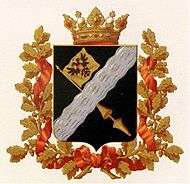Coat of arms of Ossetia

The coat of arms of Ossetia is a disk gules with a persian leopard passant or with sable spots on a ground or with as background seven mountains argent (i.e. a red disk with a golden snow leopard with black spots standing on a golden ground and with seven white mountains in the background). The mountains on the seal symbolize the Ossetian landscape, while the snow leopard is an iconic (but now seriously endangered) inhabitant of the Caucasus mountains
History
The Terek region

During the Russian Empire the territory of the present North Ossetia was a part of the Terek region. The coat of arms of the Terek region was approved on 15 March 1873: in a black shield a gold Imperial flag in his right band, on top of all silver wavy band left. The shield "ancient Royal" crown, around the shield with oak wreath entwined the Alexander band.
The North Ossetian ASSR

December 5, 1936 was formed the North Ossetian ASSR (soassr). In the 1940 edition of the Constitution of the soassr said:
"The state emblem of the North Ossetian Autonomous Soviet Socialist Republic is the state emblem of the RSFSR, which consists of a Golden sickle and hammer placed crosswise, handles downward, on a red background in the sun and framed by ears of corn, with the inscription "RSFSR" and "Proletarians of all countries, unite!" in Russian and Ossetian languages (RSFSR / USSR) (ÆППÆТ БÆСТÆТЫ ПРОЛЕТАРТÆ BAIU UT!) with the addition of under the inscription "RSFSR" letters smaller lettering "North Ossetian ASSR" in both Russian and Ossetian languages. (ЦÆГАТ-IRESTONE ASSR)" (article 111).
In 1978 the arms of the soassr (as in the coat of arms of the RSFSR) was added red star.
The modern coat of arms
.png)
November 24, 1994 was approved and enacted by Parliament Act No. 521 on the coat of arms of the Republic. The author of the picture — Murat Jigkaev. The prototype of the emblem was the figure of the "banner of Ossetia" Vakhushti Bagrationi, dated 1735. A red flag was a picture of Persian (Persian, Caucasian) leopard (leopard) on a background of blue mountains. The identification of the figure with the snow leopard (IRBIS) is erroneous. IRBIS never lived in the Caucasus. The Persian leopard (lat. Panthera pardus ciscaucasica or Panthera pardus saxicolor) can be externally (depending on the painting) is very similar to the snow leopard.

